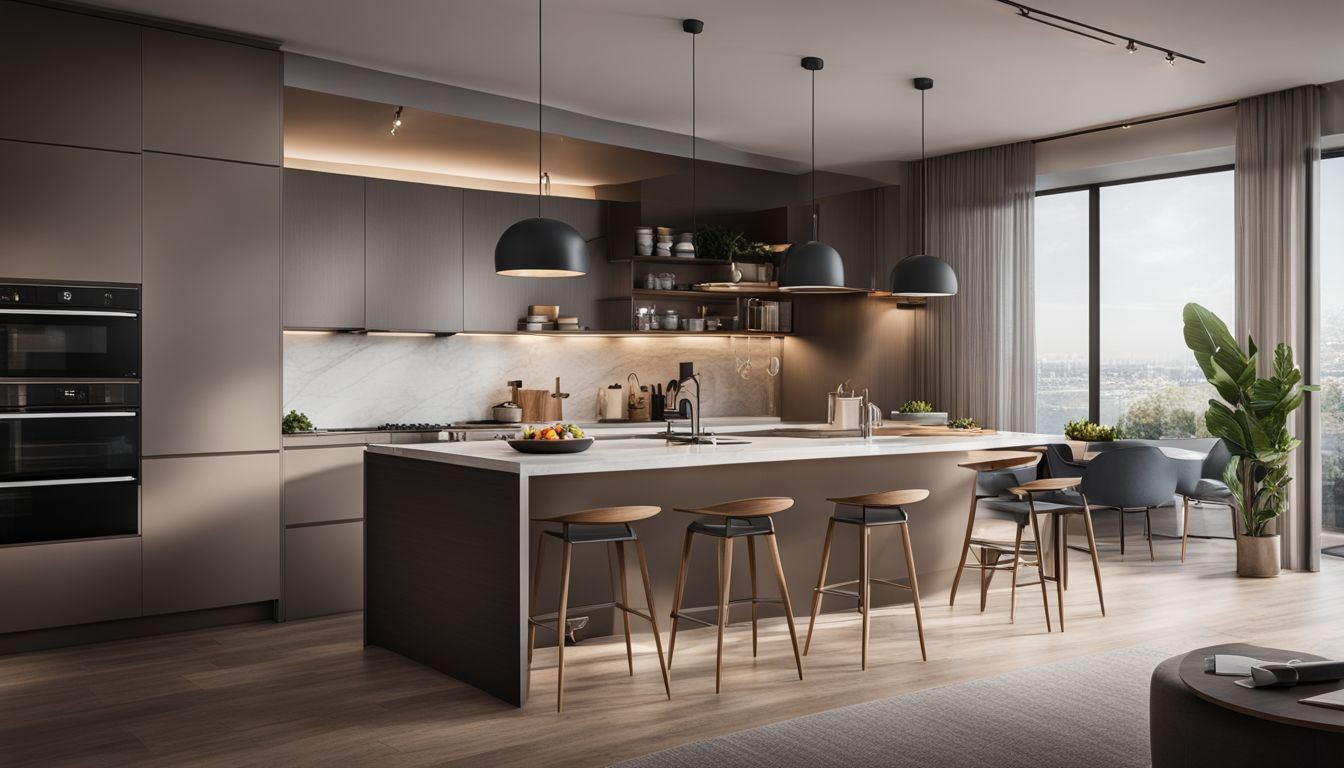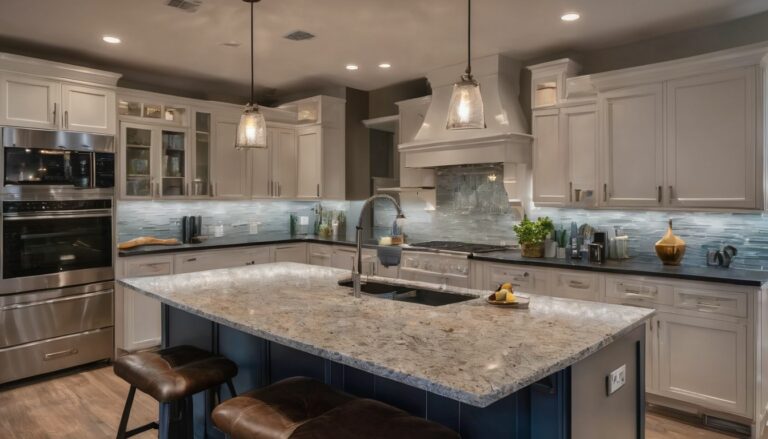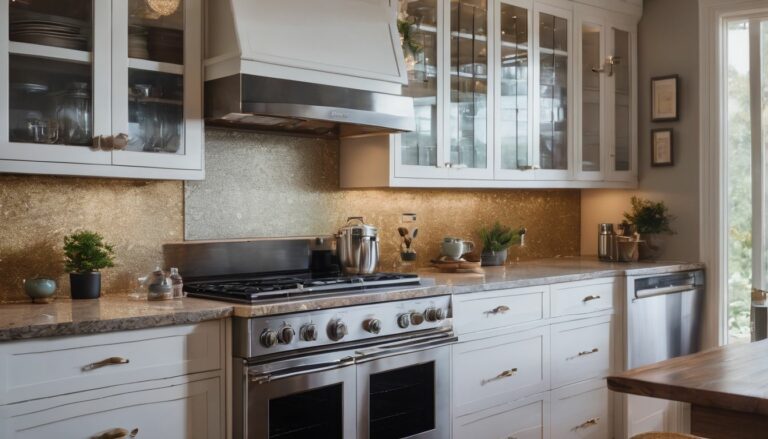Effortless Guide: How to Ventilate a Kitchen Without Windows – Fresh Tips
Having a kitchen without windows can indeed seem like drawing the short straw, particularly when it comes to ventilation. I know that firsthand; believe me, it’s like your dinner party goes on for days thanks to those lingering cooking smells! But after much trial and error, not to mention countless deep-dives into different solutions, I’ve discovered several effective ways to ventilate a windowless kitchen.
So grab your toolbelt – or just your curiosity – because we’re about to tackle this conundrum head-on!
Key Takeaways
- Good ventilation is important in a kitchen without windows to keep the air fresh, cool, and healthy.
- Effective ways to ventilate a windowless kitchen include using the door, installing a ceiling fan or range hood, utilizing air purifying plants or an HEPA air purifier, opening windows in nearby rooms, and considering mechanical ventilation systems like MVHR or SRHR systems.
- Extractor fans are crucial for removing cooking emissions and maintaining clean air in a windowless kitchen.
- When choosing an extractor fan, consider the size of your kitchen, whether you want ducted or ductless options, and look for low noise levels.
- Natural ventilation techniques such as cross ventilation, trickle ventilators or vents near the ceiling, ceiling fans, solar chimneys or wind towers can also be used to improve airflow in a windowless kitchen.
Why Proper Ventilation is Important in a Kitchen Without Windows

Good air circulation is key in a kitchen without windows. It keeps the space cool and nice to cook in. Having a fan to push out bad air can be very helpful. This makes sure that you are not breathing in stuff that could make your lungs sick.
A good flow of air also gets rid of smells from cooking. It helps keep the indoor air fresh and healthy for everyone who comes into your kitchen! A well-ventilated kitchen stops dampness too, which can harm both people’s health and the building itself.
So, proper ventilation is really important for keeping your windowless kitchen safe and pleasant to use.
How to Ventilate a Kitchen Without Windows

There are several effective ways to ventilate a kitchen without windows, such as using the door, installing a ceiling fan, mounting a range hood, and utilizing air purifying plants.
Use the Door
Let’s start with the door. Yes, the door! It can be a big helper when you need air to move around in a kitchen with no windows. Keep your main door open as often as you can. This will let fresh air come into the kitchen from other parts of your house.
Just be careful if there are kids or pets – make sure they stay safe while the door is open.
The best time to do this? Try it when you’re cooking something that makes lots of fumes or smells strong. Cooking fumes don’t just smell bad – they can also hurt your health if you breathe them in for too long.
So using the door helps keep your kitchen’s air clean and safe to breathe.
Install a Ceiling Fan
Let’s jazz up your kitchen with a ceiling fan. It is a great way to move around hot air. Install it, turn it on and feel the difference right away. Hot air gets lifted up and moved out of the way.
Be careful though! Make sure you don’t point fans at people. You don’t want to blow dirty air at them! Fans work well even when there are no open windows nearby. Plus, they save energy while cooling down your house too.
Does this sound good? Let’s get started!
Mount a Range Hood
One effective way to improve ventilation in a kitchen without windows is to mount a range hood. By installing a range hood above your stovetop, you can effectively remove smoke, odors, and harmful chemicals that are released during cooking.
Range hoods with vents help to expel these pollutants outside of your kitchen, improving the air quality inside. If there is no option for venting outside, you can also consider using a ductless range hood or converting an existing range hood into a ductless one.
These alternatives filter the air through charcoal filters before recirculating it back into the kitchen. While vented combination microwave hoods can save space in your kitchen, they may not be as powerful as traditional range hoods in terms of exhaust capacity.
So if possible, opting for a dedicated range hood would be more beneficial for proper ventilation in your windowless kitchen.
Air Purifying Plants
I love having air purifying plants in my kitchen because they help improve indoor air quality. Although there’s no definitive proof that plants significantly purify the air, indoor houseplants like aloe vera can still make a difference.
They can help clean the air, eliminate odors, and contribute to a healthier home environment. Adding some greenery to your kitchen is a natural way to improve the quality of the air you breathe.
Open Windows in Nearby Rooms
Opening windows in nearby rooms is a simple yet effective way to ventilate a kitchen without windows. It allows for fresh air to flow into the space, improving indoor air quality. When windows are opened in adjacent rooms, natural airflow can help circulate air throughout the kitchen and remove any stagnant or odorous air.
By creating this exchange of air, you can enhance ventilation and create a healthier environment in your windowless kitchen. Additionally, opening doors between rooms can also aid in increasing airflow and promoting better ventilation throughout your home.
Ventilation solutions that involve using open windows in nearby rooms have been widely used to improve indoor air quality. Buildings naturally breathe through openings like doors and windows whenever they are opened, allowing for fresh outdoor air to enter while stale indoor air exits.
In fact, natural ventilation is commonly relied upon in spaces like patient wards where there may not be access to traditional windows. By strategically utilizing open windows across different areas of your home, you can facilitate the circulation of fresh air even without having direct access to external sources of ventilation.
To further enhance the effectiveness of using open windows from other rooms for ventilation purposes, consider placing fans near these openings to encourage better airflow into your kitchen area.
This strategic fan placement will help push fresh outdoor air towards the kitchen space while facilitating the expulsion of stale or polluted indoor air outside. The combination of opening nearby room’s windows with properly positioned fans will greatly contribute to improving ventilation within your windowless kitchen.
Use a HEPA Air Purifier
A HEPA air purifier is a great way to improve ventilation in a kitchen without windows. These air purifiers have special filters that can remove odors and particles from the air, which helps to keep the kitchen smelling fresh and clean.
By using a HEPA air purifier, you can ensure that the indoor air quality in your windowless kitchen is improved, making it a healthier environment for cooking and eating. So consider investing in a portable air cleaner with a mechanical filter (HEPA) to help improve the ventilation in your windowless kitchen.
Open Doors
In a kitchen without windows, opening the doors can be an effective way to improve ventilation. By leaving the doors open, you allow air to circulate and move more freely throughout the space.
This helps to prevent stale air from accumulating and promotes better air quality. Opening doors in the kitchen is a simple method that can make a noticeable difference in reducing odors and improving overall airflow.
So, don’t hesitate to give it a try if you want to enhance ventilation in your windowless kitchen!
Borrow Air from Another Room
One effective way to ventilate a kitchen without windows is by borrowing air from another room. By doing this, you can improve the air quality in your windowless kitchen and bring in fresh air from a different area of your home.
It helps create better circulation of air within the kitchen, reducing the build-up of stale air and odors. This method involves creating a flow of air between rooms, allowing for proper ventilation and improvement in indoor air quality.
So if you’re looking for a simple solution to ventilate your windowless kitchen, consider borrowing some fresh air from another room in your house.
Consider MVHR or SRHR Systems
When ventilating a kitchen without windows, one effective option to consider is MVHR or SRHR systems. These mechanical ventilation systems help extract moisture and stale air from the kitchen while also recovering heat.
MVHR (Mechanical Ventilation with Heat Recovery) is an energy-efficient and balanced ventilation system that not only improves air quality but also helps save on heating costs. Another option is the Single Room Heat Recovery (SRHR) unit called heatSava, which provides similar benefits in terms of fresh air and heat recovery.
These systems are especially useful in windowless kitchens where natural ventilation is limited. By considering these options, you can ensure proper ventilation and maintain a healthy environment in your kitchen without windows.
The Importance of Extractor Fans
Extractor fans are incredibly important for ventilating a kitchen without windows. They play a crucial role in maintaining proper airflow and removing cooking emissions, such as smoke and odors, from the kitchen area.
Without these fans, the smog created during cooking can linger in the air and affect the overall air quality inside your home.
Quality range hoods or exhaust systems are especially effective at capturing and extracting pollutants directly at the stove. This prevents them from mixing into the surrounding air and spreading throughout your home.
By installing an extractor fan, you can ensure that any harmful particles or gases produced during cooking are quickly removed, improving indoor air quality and creating a healthier living environment for you and your family.
So, when it comes to ventilating a kitchen without windows, don’t overlook the importance of having an extractor fan installed. It is an essential component for effectively controlling kitchen smog and promoting clean, fresh air circulation inside your home.
How to Choose the Right Extractor Fan
Choosing the right extractor fan is really important when it comes to ventilating a kitchen without windows. There are a few things you should consider. First, think about the size of your kitchen and how much ventilation it needs.
If you have a big kitchen or do a lot of cooking, you’ll need a more powerful fan. Next, think about whether you want a ducted or ductless extractor fan. Ducted fans remove the air from your kitchen through a pipe, while ductless fans filter the air and then release it back into the room.
Lastly, look for an extractor fan with low noise levels so that your kitchen stays quiet while it’s running.
Using Natural Ventilation Techniques
Natural ventilation techniques can be effective in providing airflow and cooling in a kitchen without windows. Here are some ways to achieve this:
- Utilize cross ventilation by opening doors and windows in adjacent rooms. This allows fresh air to flow through the kitchen.
- Install trickle ventilators or vents near the ceiling to bring in fresh air from outside.
- Use ceiling fans to promote air circulation and keep the kitchen cool.
- Consider using a solar chimney or wind tower, which harness natural air movement to ventilate the space.
- Place indoor plants near windows or other openings to help filter and purify the air.
The Role of Dehumidifiers in Kitchen Ventilation
Dehumidifiers play a crucial role in kitchen ventilation, especially when there are no windows present. These devices help with humidity control and moisture regulation, which are important for maintaining good indoor air quality.
By removing excess moisture from the air, dehumidifiers help prevent mold growth, condensation buildup, and musty smells in the kitchen.
When placed in a kitchen without windows, dehumidifiers work to eliminate dampness and keep the environment dry. This is particularly helpful in preventing issues like foggy windows and funky odors.
To ensure that dehumidifiers work effectively, it’s important to keep windows, doors, and vents closed so that the device can efficiently remove water from the air.
In summary, using a dehumidifier in a windowless kitchen is an effective way to control humidity levels and improve ventilation. By eliminating excess moisture from the air, these devices contribute to better indoor air quality and prevent moisture-related problems in your kitchen.
Other Tips for Improving Kitchen Air Quality
Use a splatter screen while cooking to prevent grease and oil from entering the air, limit the amount of furniture in the kitchen to allow for better airflow, utilize scented candles or essential oils to freshen the air, and opt for porous materials such as bamboo or cork flooring that can absorb odors.
Use a Splatter Screen
A splatter screen is a useful and affordable tool that can help keep your stove clean while improving the air quality in your kitchen. It acts as a barrier to prevent messy splatters of grease from getting all over your countertops and walls.
By using a splatter screen, you can greatly reduce the amount of airborne particles, such as grease and oil, that can contribute to poor indoor air quality. Additionally, it helps to minimize cooking smells by containing them within the pan or pot you’re using.
Investing in a splatter screen is an effective way to improve kitchen ventilation and maintain a cleaner and healthier cooking environment for everyone in your home.
Limit Furniture in the Kitchen
Having too much furniture in the kitchen can actually affect the air quality. Furniture, like tables and chairs, can contribute to indoor air pollution by trapping dust and allergens.
It can also hinder proper air circulation and ventilation in the kitchen. By limiting the amount of furniture in your kitchen, you can reduce these issues. Having less furniture makes it easier to clean and maintain hygiene standards in your kitchen as well.
So if you want to improve the air quality in your windowless kitchen, consider minimizing the furniture present in it.
Utilize Scented Candles
I’ve learned that scented candles may not be the best option for improving air quality in a kitchen without windows. Burning scented candles releases harmful toxins and soot into the air, which can pose health hazards and contribute to poor indoor air quality.
These carcinogenic toxins and chemicals are not ideal for breathing and can even stain walls and furniture, as well as contaminate the home’s ventilation system. It’s important to prioritize the use of unscented candles or explore alternative methods for improving kitchen air quality rather than relying on scented candles.
Use Porous Materials
Using porous materials is a simple and effective way to improve the air quality in a kitchen without windows. Porous materials, such as cork or natural stone countertops, can absorb and trap pollutants like cooking fumes, allergens, and volatile organic compounds (VOCs).
By incorporating these materials into your kitchen design, you can create a cleaner and healthier environment for cooking and food preparation. Not only do porous materials help reduce the presence of contaminants in the air, but they also add an aesthetic appeal to your kitchen space.
So consider using them as part of your strategy to improve kitchen ventilation and maintain a healthy indoor environment.
How to Ventilate a Basement Kitchen Without Windows
Ventilating a basement kitchen without windows can be challenging, but there are effective ways to ensure proper airflow. Here are some methods to consider:
- Install an extractor fan: An extractor fan is a great way to remove cooking fumes and improve air circulation. Make sure to choose a large fan suitable for a small kitchen without windows.
- Use air conditioning: Installing an air conditioning system can help maintain fresh air in the basement kitchen. It also helps control humidity levels and provides ventilation.
- Utilize ventilation fans: Consider using grills or ventilation fans between rooms to allow air to circulate from other areas of the house into the kitchen.
- Create purpose-built openings: Natural ventilation can be achieved by creating purpose-built openings such as windows, doors, solar chimneys, wind towers, and trickle ventilators in the basement.
- Ensure airtightness: While it is important to prevent fresh air from entering without windows, seek professional advice on maintaining appropriate airtightness levels in your basement kitchen.
Conclusion
In conclusion, there are several effective ways to ventilate a kitchen without windows. By using strategies such as opening doors, installing a ceiling fan or range hood, and utilizing air purifying plants or an HEPA air purifier, you can improve the air quality and circulation in your windowless kitchen.
Additionally, employing natural ventilation techniques, using a splatter screen while cooking, and limiting furniture in the kitchen can also contribute to better ventilation. Remember that proper ventilation is important for maintaining a healthy and comfortable environment while cooking in a kitchen without windows.
FAQs
1. How can I ventilate a kitchen without windows?
You can use ventilation methods such as installing an exhaust fan, using a range hood with ductwork, or using portable air purifiers to circulate the air and remove odors.
2. What is the purpose of ventilating a kitchen without windows?
Ventilating a kitchen without windows helps to remove cooking odors, moisture, smoke, and indoor air pollutants for a healthier and more comfortable living environment.
3. Can I rely on natural ventilation options if my kitchen has no windows?
Natural ventilation options like opening doors or using vents in other areas may provide some airflow, but they may not be as effective as mechanical ventilation methods in completely removing odors and improving air quality.
4. Are there any alternative solutions to ventilate my windowless kitchen effectively?
Yes, you can consider installing carbon filters in your exhaust fan or range hood to help eliminate odor-causing particles from the air more effectively.
5. Is it essential to consult a professional for proper installation of ventilation systems in a windowless kitchen?
While it is possible to install some ventilation systems yourself, it’s important to consult with professionals for expert advice and proper installation of complex systems like ductwork or exhaust fans for optimal performance and safety.







